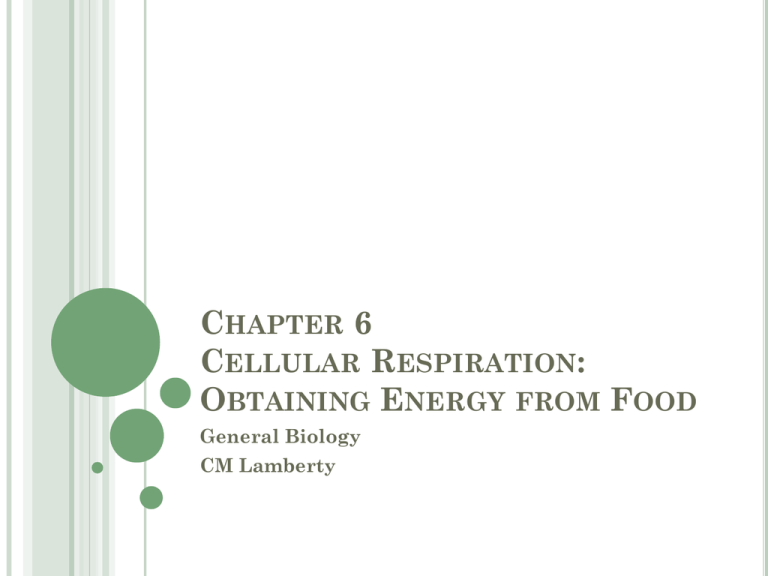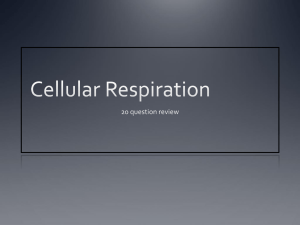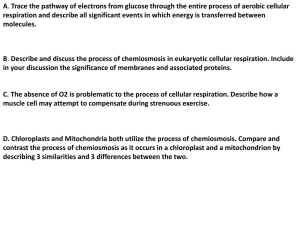Chapter 6 Cellular Respiration
advertisement

CHAPTER 6 CELLULAR RESPIRATION: OBTAINING ENERGY FROM FOOD General Biology CM Lamberty BIOLOGY AND SOCIETY ENERGY FLOW AND CHEMICAL CYCLING Animals depend on plants to covert solar energy to Photosynthesis PRODUCERS AND CONSUMERS Plants and other autotrophs (self-feeders) Heterotrophs (other-feeders) Producers Consumers CHEMICAL CYCLYING: PHOTOSYNTHESIS AND CELLULAR RESPIRATION Chemical ingredients for photosynthesis Chloroplasts Cellular respiration CHEMICAL CYCLYING: PHOTOSYNTHESIS AND CELLULAR RESPIRATION Waste products of cellular respiration Animals Plants CELLULAR RESPIRATION : AEROBIC HARVEST OF FOOD ENERGY Respiration Cellular respiration OVERALL EQUATION OF CELLULAR RESPIRATION Glucose Many chemical steps ROLE OF OXYGEN IN CELLULAR RESPIRATION 38 ATP for each glucose REDOX REACTIONS Chemical reactions involving transfer of electrons Loss of electrons: Gain of electrons: Cellular respiration is a fall of electrons Results in release of energy NADH AND ELECTRON TRANSPORT CHAINS Path of electrons from glucose to oxygen NAD+ (nicotinamide adenine dinucleotide) NADH transfers electrons via electron transport chain OVERVIEW OF CELLULAR RESPIRATION Metabolic pathway Three stages of cellular respiration Glycolysis Citric acid cycle (Krebs cycle) Electron transport THREE STAGES OF CELLULAR RESPIRATION Stage 1: Glycolysis (w/ most of E) INPUT OUTPUT 2 ATP 2 ADP Glucose Key Carbon atom Phosphate group High-energy electron Energy investment phase Figure 6.7-1 THREE STAGES OF CELLULAR RESPIRATION Stage 2: Citric Acid Cycle THREE STAGES OF CELLULAR RESPIRATION Stage 3: Electron Transport VERSATILITY OF CELLULAR RESPIRATION Cellular respiration can also “burn”: Diverse types of carbohydrates Fats proteins ADDING UP THE ATP FROM CELLULAR RESPIRATION Remember up to 38 ATP/glucose Glycolysis and citric acid cycle each contribute 2 ATP by direct synthesis Remaining from “fall” of electrons in transport chain Each pair dropped down from NADH = 3 ATP Each pair dropped down from FADH2 = 2 ATP FERMENTATION: ANAEROBIC HARVEST OF FOOD ENERGY Cells can work for short periods w/o O2 Fermentation is anaerobic harvest of food energy FERMENTATION IN HUMAN MUSCLE CELLS FERMENTATION IN MICROORGANISMS Fermentation alone is able to sustain many microorganisms The lactic acid produced by microbes is used to produce: LIFE BEFORE AND AFTER OXYGEN Glycolysis used by ancient bacteria to make ATP when little oxygen available and before organelles evovled Today glycolysis Occurs in almost all organisms Is a metabolic heirloom of the first stage in the breakdown of organic molecules









